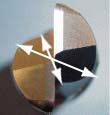Yes. Zero Divide is correct. To accurately predict chatter with the software, you will need to do physical tests. To do this, you will need an impact hammer with an integrated force sensor (Kistler, Dytran, PCB, etc), an accelerometer and an I/O box. If you want really accurate results at low frequencies you can use a laser displacement sensor instead of an accelerometer. I know Keyence is one company that manufactures these, though these sensors are significantly more money than accelerometers. You will also need an I/O box (National Instruments sells some) to capture the signals.
In a nutshell, you place the sensor on the tool directly opposite to the direction of impact and hammer the tool. The hammer will measure the applied force and the accelerometer will indirectly measure the displacement. By dividing displacement by force at each frequency you can get the stiffness/ of all the modes of the machine at the tool point you measured. The dynamics of the entire machine / tool / spindle assembly will be captured as reflected at the tool tip. Using this, your radial immersion (slot, half, quarter cutting), some fancy equations and a material model, the software can predict the saw-tooth shaped lobes where depth of cut and RPM are ideal.
The two main companies that I know if of that sell this software are:
MALINC - Cutpro
Machine Tool Testing Software and Machining Problem Diagnosis Software
Manufacturing Laboratories Inc - Harmonizer
Manufacturing Laboratories, Inc. (MLI)
You can also write your own code for 2D milling. It can be found in:
http://www.amazon.com/Manufacturing-Automation-Cutting-Mechanics-Vibrations/dp/110700148X
However, you will still need the hammer setup to find the machine dynamics. You will also need to find the cutting coefficients. You may be able to obtain estimates of these from sources like Sandvik (their catalogues). In my opinion for chatter prediction, the software is really only useful for 2D / 3D milling cases. It is not there yet for 5-axis sculptured surface machining or in very low RPM machining. However, in time these will be modeled more accurately.
To eliminate the impact testing with the hammer and simulate the dynamics of the machine requires finite element (FE) modeling. Although these can estimate the stiffness of structures, they cannot find the damping - this is impossible to predict as of today. Also, FE is notoriously unreliable if not checked and tuned with the real world system. The expression "Simulation is like masturbation. The more you do it, the more you think it's real", could not be more correct.
Barbter: Yes I love the corncob cutters for roughing too. They make the tool behave like one with the stability of a one-fluted cutter but remove material like a multi-fluted cutter. Combine with variable pitch and these things can devour nasty alloys at insane depths of cut with virtually no chatter.


 . Sounds crazy but i tested that.
. Sounds crazy but i tested that. )
)
